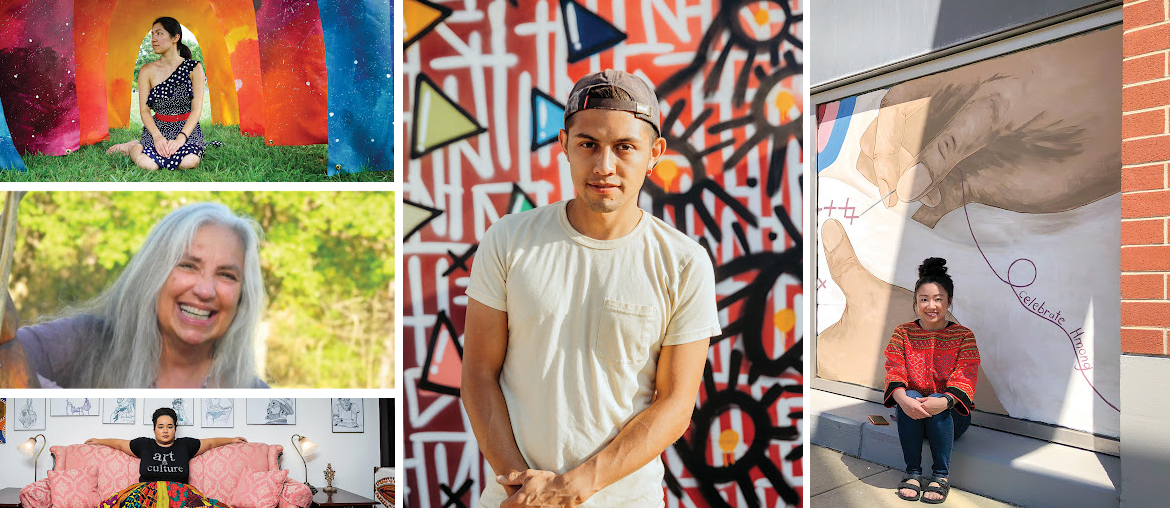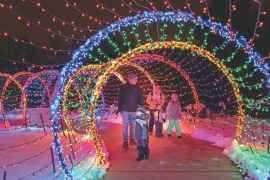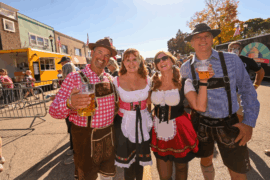By Hywania Thompson
ROSY PETRI ON EVERYDAY INSPIRATION
Rosy Petri is a self-taught, multi-disciplinary artist who believes creativity is part of the human spirit and that anyone can harness it with whatever is around them.
Petri creates primarily in fabric. She says she loves the accessibility of fiber and how it’s present in everyday lives. Petri draws her inspiration from people and from stained glass windows in churches and cathedrals — as well as African diasporan culture in food, textiles, music and architecture. “I love history, culture, adventure and stories, but I’m also a bit of an introvert,” says Petri. “I like listening deeply to what folks have mastered, then sharing those lessons with the world around me through my work.”
Currently, she’s serving as the inaugural artist in residence at the bell hooks center at Berea College in Kentucky. Some of her works can be seen at the Sherman Phoenix market in Milwaukee.
@thisisparadisehome, thisisparadisehome.com
KAREN ANN HOFFMAN ON CULTURAL CONTENT
For 25 years, artist Karen Ann Hoffman has been creating Haudenosaunee (hoe-dee-no- SHOW-nee) Raised Beadwork — a practice that’s recognized by the tight linework of beads sewn onto the surface of velvet.
The art form dates back thousands of years but was popularized in the 19th century when it was crafted and sold to tourists around Niagara Falls. Today, Hoffman uses it to stay connected to her Oneida heritage. The Oneida Indian Nation is one of six tribal nations that belong to the Haudenosaunee, an alliance more commonly known as the Iroquois Confederacy. (The Iroquois name came from the French).
Hoffman, who lives in Stevens Point, is known for her legacy pieces: large, substantial works — such as bandolier bags, Council mats and urns — with deep cultural connections. These works are a visual representation of native storytelling, like the origin of the Haudenosaunee.
Many of Hoffman’s legacy pieces are displayed in a variety of institutions across the country — such as the Wisconsin Historical Society in Madison, Chicago Field Museum and the Smithsonian National Museum of the American Indian located in Washington D.C. and New York.
Out of responsibility to her heritage, Hoffman also began taking on apprentices and teaching some workshops to share her craft and continue the legacy.
@karenann.hoffman, karenannhoffman.com
JENIE GAO ON ENSURING EQUITY
Rooted in storytelling and social good, Jenie Gao’s work often presents itself in the form of printmaking, murals and public art. Her artistic process includes elements of social good, like conducting interviews and collecting feedback to help ensure her art contributes to the overall wellbeing of the community.
She’s built her Madison studio as an “anti-gentrification art business, because Iʼm tired of even well-meaning causes using art in a way that exploits artists and displaces BIPOC, LGBTQ+, senior and working-class communities.”
With that in mind, Gao designs projects that empower those who work on them, and says she ensures they’re paid fairly. Over the last three years, Gao has mentored more than 20 paid interns and apprentices. “Despite the obstacles and inequities, artists still manage to be leaders and changemakers that regularly envision different futures we could head toward,” says Gao.
Gao recently relocated to Vancouver, BC, Canada to begin a graduate program. Her Madison studio will remain open, and she’ll have a smaller studio in Vancouver too.
LIUBOV “TRIANGULADOR” SZWAKO ON PURSUING CURIOSITY
Curiosity is what drives Liubov Szwako — who is known artistically as “Triangulador” — and he says he enjoys the process of experimenting with different paints, textures and shapes. Szwako, who was born in Mexico City and moved to Madison about 12 years ago, began painting out of curiosity and found his passion in the process. The first thing he ever made was a triangle, so he decided to take on the moniker, Triangulador — “triangle maker” in Spanish.
Szwako creates murals, paintings and textile art — “anything I can paint, I paint,” he says. “My art is abstract; my art is pretty freeing, and the moment that I try to do something — to become something else — it’s not me,” says Szwako, adding that, “I stay true to that feeling of ‘I’m going to do whatever feels good.’”
His street art can be seen throughout Madison, such as in the right image (2526 Monroe Street).
He encourages others to pursue their interests. “Just give it a shot. Not to be the best, but to experience what it feels like.”
@triangulador, triangulador.com
NOU VUE ON HMONG CULTURE AND TRADITIONS
Appleton-based Nou Vue taps into her Hmong heritage when she creates and works in various mediums, but mainly via paintings and drawings.
“Creating works pertaining to Hmong culture allows me to reveal bits and pieces of my identity to the audience,” says Vue. “I want viewers to appreciate the beauty of my culture and respect its uniqueness.”
Vue says people thrive when learning from, accepting and appreciating others. Earlier this year, she was tapped by the Fox Cities Performing Arts Center in celebration of Hmong Heritage Month. On the center’s wall of windows, she painted a series of flowers and geometric-like shapes that represented patterns and stitches often used in Hmong embroidered clothing — which borrows inspiration from, and takes on the form of, nature.






Comments are closed.